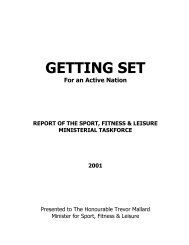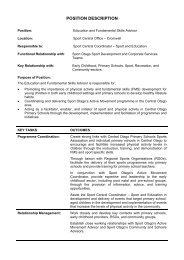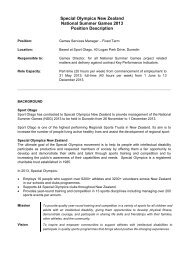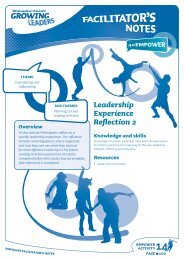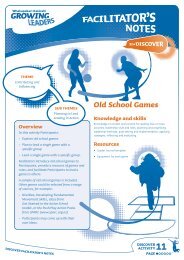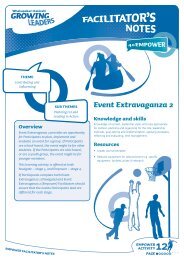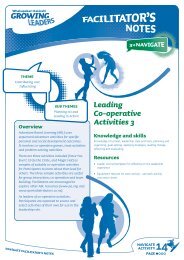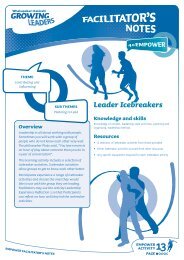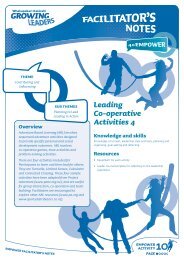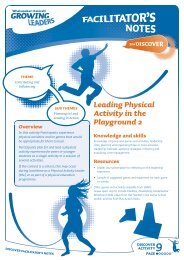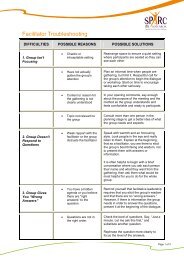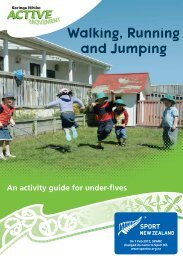Craig Tiley - player and coach development (PDF, 414 Kb)
Craig Tiley - player and coach development (PDF, 414 Kb)
Craig Tiley - player and coach development (PDF, 414 Kb)
You also want an ePaper? Increase the reach of your titles
YUMPU automatically turns print PDFs into web optimized ePapers that Google loves.
Player <strong>and</strong> Coach Development<br />
“Refocusing to Win”
Re-igniting a Tennis Nation…….<br />
The Action Plan<br />
I. Identify the Issues<br />
II. Define the Development Principles<br />
III. Develop the Strategy<br />
IV. Drive the Change<br />
“We don’t need a message of action but a message of persistent<br />
<strong>and</strong> additional action”
I. Identify the Issues
Australian Tennis in Crisis – The Decline<br />
1. A 15 year decline of Australian <strong>player</strong>s ranked inside the top 500 on the<br />
professional tours<br />
2. The average age of ranked Australian <strong>player</strong>s in the top 500 is well<br />
above the international average<br />
3. The last Australian <strong>player</strong> to win out of his/her age group did so ten<br />
years ago<br />
4. No Australian <strong>player</strong> has transitioned into the top 100 within 12 – 18<br />
months after juniors, since Lleyton Hewitt<br />
5. No junior <strong>player</strong>s have been clearly dominant internationally for the<br />
past 15 years
6. Australia has consistently shown the weakest transition from juniors to the<br />
professional rankings compared to other tennis nations<br />
Countries<br />
Australia France Spain USA Russia Czech Engl<strong>and</strong> China Argentina Brazil<br />
Population (November 2005) 20.1 Million 60.7 Million 40.3 Million 296 Million 143.1 Million 10.2 Million 60.4 Million 1.30 Billion 39.6 Million 186.8 Million<br />
Boys (B) / Girls (G) B G B G B G B G B G B G B G B G B G B G<br />
ITF 150 10 5 3 2 1 0 21 20 4 22 8 8 2 2 2 3 3 1 5 3<br />
ITF 300 19 10 9 3 2 0 30 34 12 33 8 11 8 8 3 4 5 1 8 5<br />
ITF 400 - 16's 9 8 2 2 0 0 9 10 3 19 3 6 2 4 0 2 0 0 0 2<br />
ITF 600 - 16's 9 9 2 3 0 0 12 14 7 21 4 7 3 6 0 2 0 0 0 3<br />
ITF Ranked - 15 (total) 8 14 7 9 3 4 14 25 15 34 3 15 2 13 3 2 1 2 0 3<br />
ITF Ranked Players (total) 66 68 40 44 33 20 129 167 81 125 40 24 59 62 13 8 39 32 60 39<br />
Male(M) / Female (F) M W M W M W M W M W M W M W M W M W M W<br />
ATP/WTA 100 2 2 9 8 12 6 8 10 5 14 8 6 3 0 0 3 10 2 0 0<br />
ATP/WTA 200 5 4 21 13 20 9 17 23 7 20 10 15 4 1 2 7 15 5 7 1<br />
ATP/WTA 350 10 8 28 17 31 12 31 36 9 29 16 23 12 5 3 10 27 10 11 4<br />
ATP/WTA 500 15 17 36 31 42 20 42 46 12 37 24 29 19 11 3 11 34 14 16 5
Flawed Strategy<br />
1. Excessive governance <strong>and</strong> administration requirements in high<br />
performance<br />
2. Lack of accountability <strong>and</strong> responsibility of athletes <strong>and</strong> <strong>coach</strong>es<br />
3. Athletes allowed to dictate training loads <strong>and</strong> support – Athlete driven<br />
programs<br />
4. Lack of national curriculum for skill <strong>development</strong>, tactics <strong>and</strong> physical<br />
training.<br />
5. Lack of a holistic view by parents, <strong>coach</strong>es <strong>and</strong> athletes<br />
6. No ability to directly influence the st<strong>and</strong>ard of <strong>coach</strong>ing<br />
7. Insufficient funds to drive change <strong>and</strong> implement national programs<br />
8. Uncoordinated national pathway with no clearly defined entry <strong>and</strong> exit<br />
points
II. Define the Development Principles
1. Coach Driven versus Athlete Driven Programs<br />
2. A national athlete <strong>and</strong> <strong>coach</strong> pathway with clearly defined entry<br />
<strong>and</strong> exit points<br />
3. Recognition of national <strong>and</strong> international competition<br />
4. A coordinated national program with a focus on long term<br />
athlete <strong>development</strong><br />
5. Draw on past successes – Collective training environments<br />
6. Clearly defined systems of athlete, <strong>coach</strong> <strong>and</strong> parent<br />
accountability<br />
7. Integration of sport science <strong>and</strong> available resources
8. Defining a sport specific <strong>player</strong> <strong>development</strong> model<br />
Execution<br />
Biomechanics<br />
<strong>and</strong><br />
Technique<br />
Decision<br />
Making<br />
Mental<br />
Awareness<br />
Scheduling<br />
Tactics –<br />
Doubles,<br />
Singles<br />
Physical<br />
Speed <strong>and</strong> Agility<br />
Cardiovascular<br />
Endurance<br />
Strength <strong>and</strong> Power<br />
Flexibility<br />
Speed/Agility<br />
Endurance<br />
Nutrition<br />
Hydration
9. Coaching Generation Y versus Generation X <strong>and</strong> knowing future trends<br />
Influence<br />
Baby Boomer Generation X Generation Y<br />
Role Model<br />
Men of character<br />
Men <strong>and</strong> women of<br />
character<br />
What is character?<br />
Respecting Elders<br />
Automatic<br />
Is polite<br />
Whatever?<br />
Money<br />
Earn it<br />
It is not everything<br />
Give it to me<br />
Loyalty<br />
Work my way to the<br />
top<br />
Shortcut to the top<br />
Give me Saturday off<br />
or I will quit<br />
Change<br />
Resist it<br />
Accept it<br />
Want it<br />
Decision Making<br />
Calculated<br />
Based on research<br />
Based on advice of<br />
friends<br />
Learning<br />
Important<br />
Want structure<br />
Want freedom <strong>and</strong><br />
experiences<br />
Technology<br />
Ignorant of it<br />
Comfortable<br />
Feel it in their gut<br />
Gen Y – “They don’t care how much you know until they<br />
know how much you care.” – Peter Sheahan
10. Incorporate components of Athletic Success<br />
(as ranked in a recent survey of over 300 Olympic medallists)<br />
• Dedication <strong>and</strong> Persistence<br />
• Family <strong>and</strong> Friends<br />
• Coaches<br />
• Love of the Sport – Passion<br />
• Training program <strong>and</strong> Facilities<br />
• Natural talent<br />
• Competitiveness<br />
• Focus<br />
• Work Ethic<br />
• Financial Support
III. Develop the Strategy
Planning Pyramid<br />
Mission<br />
Strategic<br />
Plan<br />
Vision<br />
Core Values<br />
Strategic Priorities<br />
Stable<br />
Foundation<br />
Goals <strong>and</strong> Objectives<br />
Key Performance Objectives<br />
Action Plan<br />
Key Performance Indicators<br />
Business<br />
Unit<br />
Operating<br />
Plans<br />
Rewards <strong>and</strong> Recognition
IV. Drive the Change
Coach Development<br />
Strategic Priority #1: Deliver a successful national <strong>coach</strong>ing program<br />
Objectives:<br />
a. Conduct junior <strong>development</strong>, club professional <strong>and</strong> high performance <strong>coach</strong>ing courses<br />
b. Grow <strong>coach</strong> membership<br />
c. Deliver professional <strong>development</strong> programs for <strong>coach</strong>es including national<br />
conferences, online education <strong>and</strong> workshop series<br />
d. Produce world class <strong>coach</strong>ing resources<br />
Strategic Priority #2: Enhance the opportunities <strong>and</strong> well-being of athletes<br />
<strong>and</strong> parents<br />
Objectives:<br />
a. Provide parent education<br />
b. Develop direct <strong>and</strong> online athlete education opportunities
Athlete Development<br />
Strategic Priority #3: Identify <strong>and</strong> provide opportunities for talented athletes<br />
Objectives:<br />
a. Promote <strong>and</strong> grow the National Talent Search program<br />
b. Identify <strong>and</strong> resource Talent Development Coaches<br />
c. Produce Talent Identification resources<br />
d. Link Talent Identification to national programs<br />
Strategic Priority #4: Develop highly focused collective training environments<br />
Objectives:<br />
a. Develop High Performance Academies<br />
b. Increase the number, conversion <strong>and</strong> retention of scholarship holders while maintaining<br />
the highest st<strong>and</strong>ards of behaviour<br />
c. St<strong>and</strong>ardise National High Performance Academy training
Tennis Australia<br />
• Long Term Athlete Development Matrix
Training Pathway
Strategic Priority #5: Integrate sport science <strong>and</strong> medicine to enhance<br />
athlete <strong>and</strong> <strong>coach</strong> <strong>development</strong><br />
Objectives:<br />
a. Develop <strong>and</strong> adhere to all st<strong>and</strong>ardised testing protocols<br />
b. Design <strong>and</strong> implement an all-encompassing national sports medicine program<br />
Strategic Priority #6: Foster successful professional athlete performance<br />
Objectives:<br />
a. Be competitive in World Group in Fed Cup, Davis Cup <strong>and</strong> the Olympic Games<br />
b. Ensure a positive ranking improvement ratio for all athletes in the AIS Pro Tour<br />
Program<br />
c. Set an exemplary st<strong>and</strong>ard of professionalism
Tournaments & Competitions<br />
Strategic Priority #7: Integrate tournaments <strong>and</strong> competitions into a<br />
national framework<br />
Objectives:<br />
a. Align national, state <strong>and</strong> local competition formats<br />
b. Design a user-friendly national calendar<br />
c. Maintain the ongoing <strong>development</strong> of the Australian Ranking system<br />
Strategic Priority #8: Enhance junior tournaments, competitions, tours <strong>and</strong><br />
camps<br />
Objectives:<br />
a. Increase junior competitive <strong>and</strong> Australian Ranking opportunities<br />
b. Advance the consistent delivery of st<strong>and</strong>ardised tours <strong>and</strong> camps
Competitions Pathway
Strategic Priority #9: Maximise the quality <strong>and</strong> quantity of professional<br />
competitive opportunities<br />
Objectives:<br />
a. Design an annual Pro Circuit calendar reflective of our athletes’ objectives<br />
b. Develop resources <strong>and</strong> education for the advancement of Pro Circuits<br />
c. Develop <strong>and</strong> implement a model to increase the number <strong>and</strong> st<strong>and</strong>ard of Australian<br />
Money Tournaments<br />
Strategic Priority #10: Deliver successful events through a commercial<br />
promoter model<br />
Objectives:<br />
a. Identify commercial promoters for Pro Circuit <strong>and</strong> Australian Open Series events<br />
b. Implement venue buy-in <strong>and</strong>/or commercial promoter models for Pro Circuit <strong>and</strong><br />
Australian Open Series events<br />
c. Drive a uniform st<strong>and</strong>ard <strong>and</strong> consistent delivery of Pro Circuit <strong>and</strong> Australian Open<br />
Series events
IN SUMMARY…
Athlete Development<br />
BEFORE<br />
Selection subjective<br />
Programs athlete driven <strong>and</strong> adjusted<br />
to the level of the <strong>player</strong><br />
Parents kept at arms length<br />
Disjointed <strong>and</strong> uncoordinated National<br />
Athlete Pathway<br />
Tennis Players came through via<br />
natural selection<br />
NOW<br />
Selection based on criteria:<br />
-Ranking<br />
-Results<br />
-Participation<br />
Athletes meet the st<strong>and</strong>ards of the<br />
program<br />
Parents educated on their role <strong>and</strong><br />
involvement in their child’s program<br />
National Athlete Pathway with clearly<br />
defined entry <strong>and</strong> exit points<br />
Searching for the Athletes
Tournaments & Competitions<br />
BEFORE<br />
Independent selectors<br />
NOW<br />
National Coaches as selectors<br />
Junior <strong>player</strong>s compete without<br />
parents to teach independence<br />
Consider <strong>and</strong> include parents<br />
Fewer competitive opportunities<br />
16 year-olds to compete in 70-80<br />
competitive matches
Coach Development<br />
BEFORE<br />
Traditional teaching methods<br />
Manual based focus<br />
Exam-based assessment<br />
Touring <strong>coach</strong>es predominantly former<br />
<strong>player</strong>s<br />
Independent modified junior tennis<br />
programs<br />
NOW<br />
Competency based training<br />
framework<br />
On-court practical focus,<br />
Simulated <strong>and</strong> real-work<br />
environments<br />
Ongoing assessment <strong>and</strong><br />
professional <strong>development</strong><br />
Touring <strong>coach</strong>es have completed<br />
formal training <strong>and</strong> High Performance<br />
Coaches Course<br />
Nationally integrated <strong>development</strong><br />
programs such as Hot Shots
“The definition of insanity is doing the<br />
same thing over <strong>and</strong> over again <strong>and</strong><br />
expecting different results”<br />
Albert Einstein



